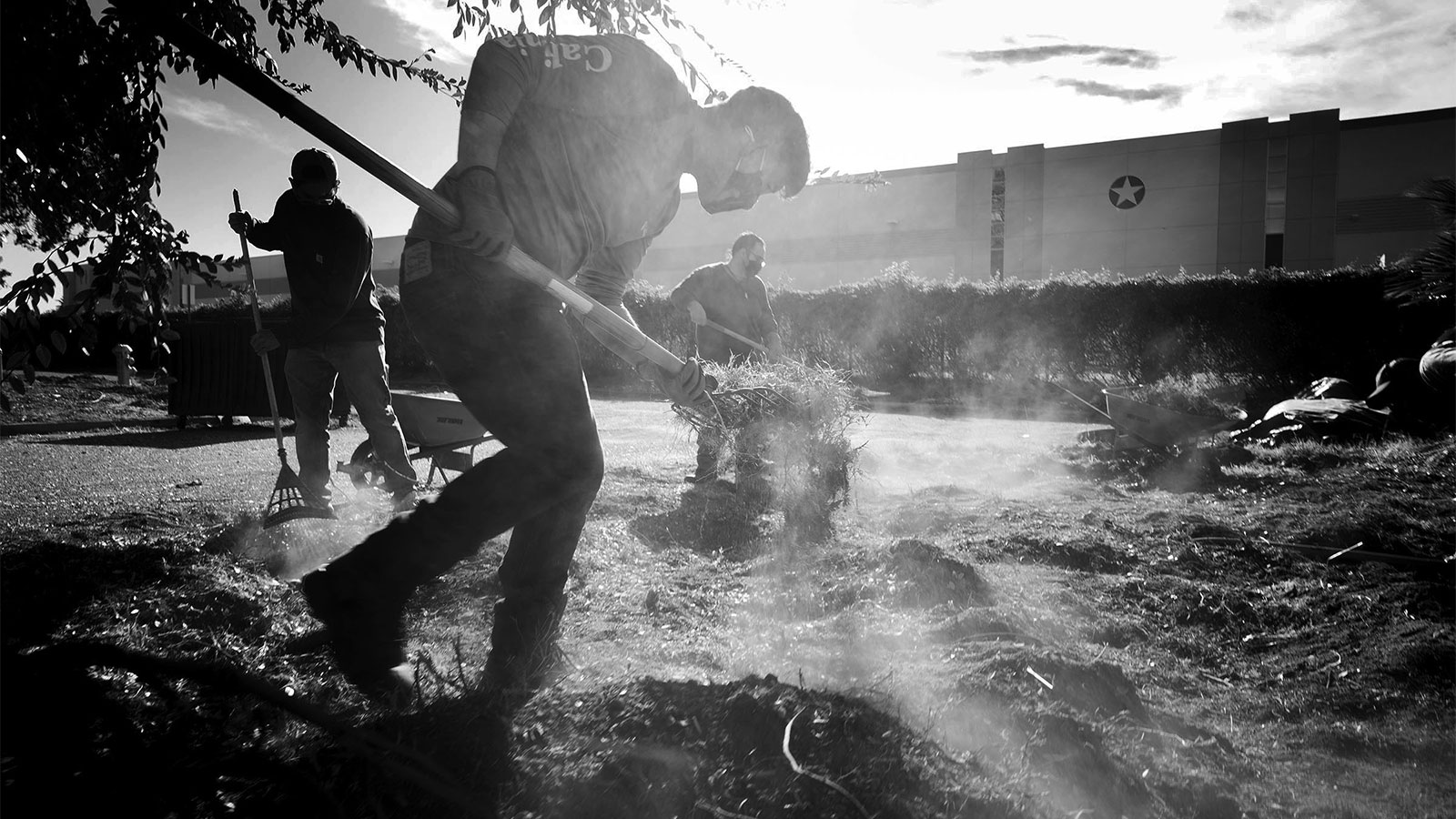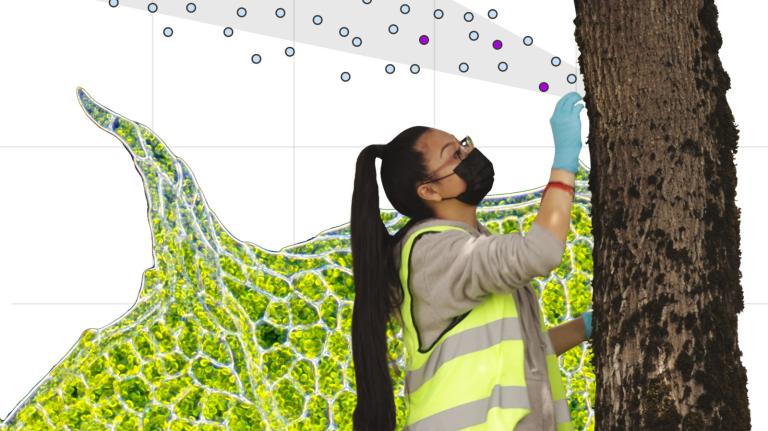When Jorge Osvaldo Heredia moved to the Southern California city of San Bernardino in 2005, the logistics and warehouse industry was already encroaching on the neighborhood where he now lives. Over the span of 15 years, he’s watched with dismay as massive warehouses have overtaken the area, leading to more truck traffic and ozone pollution. That pollution weighs most heavily on residents of Heredia’s working-class, predominantly Latino neighborhood near the San Bernardino International Airport.
“Most days the air is horrible, especially during the summer months where everything is just a hot blanket of smog,” Heredia told Grist. During that same 15-year period, the city of more than 215,000 people was battered by economic downturns, a bankruptcy, and high levels of poverty and violence. Today, the city sits at a crossroads, both geographically and metaphorically. In the hardest-hit areas, ghosts of the past linger along the city’s thoroughfares in the form of empty storefronts, fading budget motels, and blighted public spaces. The unrelenting march of time has also taken its toll on residential neighborhoods where, in the stark daylight, even the festive holiday lights decorating people’s homes last month did little to mask the peeling paint, frayed edges, and parched lawns that hard times have brought.

Jorge Osvaldo Heredia takes a break from clearing a field of weeds and debris to make way for a community garden plot for a family in San Bernardino, Calif. Daniel A. Anderson
By contrast, the warehouses, painted in neutral beiges and whites and bathed in winter’s sunlight, gleam pristinely against the backdrop of the San Bernardino mountains. They buzz with activity as heavy-duty trucks and commercial trailers rumble in and out of their gates. “This whole region has been taken over by warehouses,” said Heredia. “It’s really reaching that apex point where you can’t avoid the warehouses, you can’t avoid the trucks.”
In large part due to the consumer goods that flow from the ports of Los Angeles and Long Beach, the Inland Empire region of Southern California, which encompasses San Bernardino and Riverside counties, has emerged as one the largest warehousing hubs in the world over the past few decades, due largely to the growth of e-commerce. “The Inland Empire, probably more than any region in the United States, has disproportionately [borne]the brunt of the environmental and economic impact of goods movement, and Amazon is driving that now in the Inland Empire,” said Jake Wilson, a California State University, Long Beach, professor of sociology who co-edited the recently published book The Cost of Free Shipping: Amazon in the Global Economy.
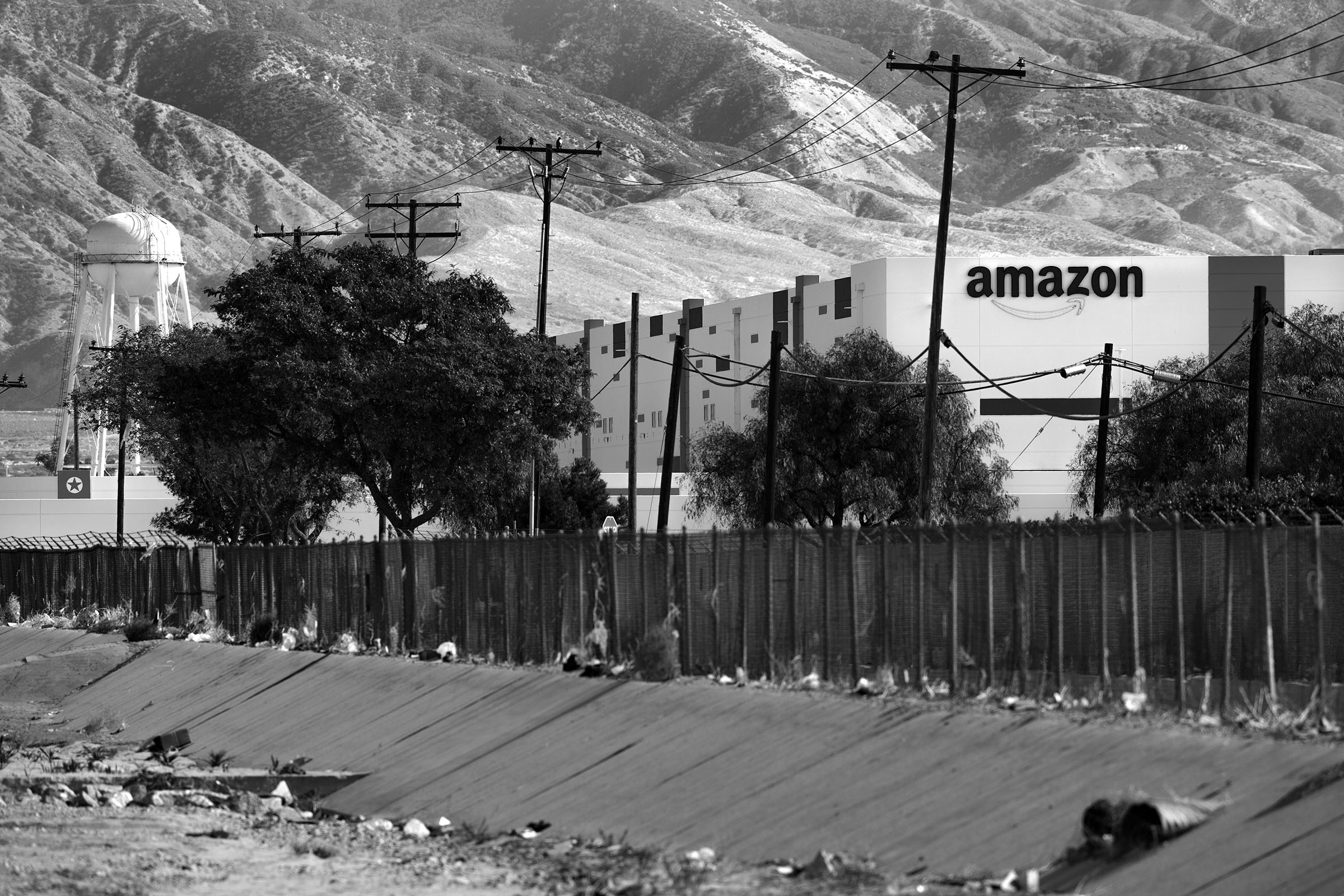
Amazon’s new commercial building at the east end of the San Bernardino International Airport. Daniel A. Anderson
Last year, residents discovered that the San Bernardino International Airport Authority planned to allow an air cargo facility development at the airport, which would allow Amazon to operate even more flights out of the region. Heredia joined a chorus of voices who protested at several public meetings and rallies, hoping that the airport authority commission would listen to residents’ concerns and halt the expansion. Instead, a year ago, in a special meeting called shortly after Christmas, the airport authority commission voted to ratify the final details of a lease that allowed the airport expansion to proceed.
Heredia was disheartened, especially given that so many in his community struggle to breathe because of respiratory conditions such as asthma and bronchitis. Many were battling serious health issues even before COVID-19 struck the region with unique severity. Heredia’s own wife was diagnosed with breast cancer in 2016, and while he says it’s difficult to pinpoint the causes of diseases like cancer, there’s no question that a healthier environment with less pollution would improve the health of all residents. “To do that, it gets so much harder when you have things stacked against you, in terms of creating the environment that would allow us to truly be healthy,” said Heredia.
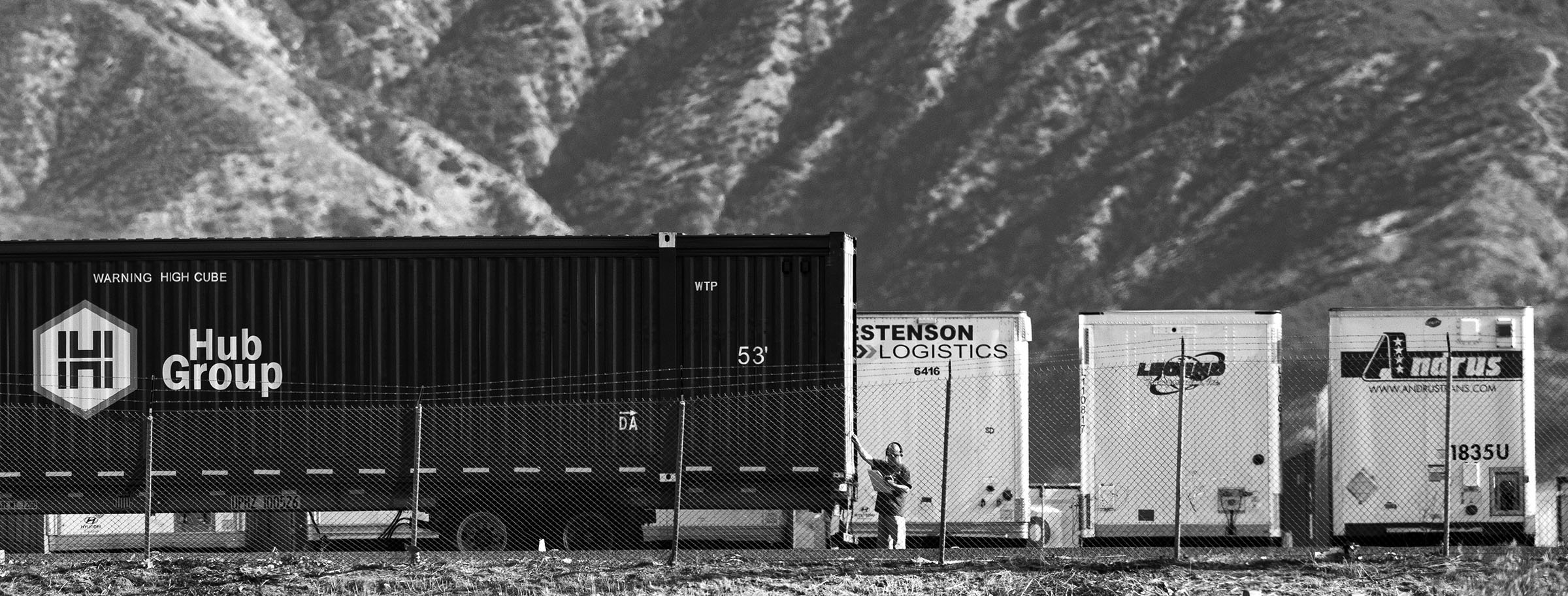
A trucker works in San Bernardino, Calif. Much of Southern California’s pollution gets trapped in this region by converging mountain ranges and daily ocean winds that push pollutants inland. Daniel A. Anderson
As the coronavirus pandemic began to spread in early 2020, Heredia said traffic decreased temporarily. But in a community where many are essential workers, that downward trend didn’t last long. As the year progressed and coronavirus cases skyrocketed, he then saw an increase in Amazon delivery trucks in his neighborhood as many consumers relied on e-commerce for their shopping needs as the state endured a lockdown. Congestion only worsened during the busy holiday season, said Heredia, who expects even more road and air traffic when Amazon begins operating flights over his neighborhood, which is bordered by several major thoroughfares and is about a mile and a half from the airport.
The airport will serve as a regional air hub for Amazon, which expects to begin operating this year with 12 daily flights — a number that will more than double within five years. (An Amazon spokesperson told Grist that its San Bernardino operations have not yet been formally announced and did not respond to follow-up questions in time for publication.) The Eastgate Air Cargo Logistics Center project, as the airport’s recent expansion is known, entails a 658,500 square-foot package sorting and distribution center with an air cargo hub. The upshot is more flights, more warehouses, more truck traffic, and a lot more pollution in a region that’s already endured the worst effects of the online commerce industry, according to Yasmine Agelidis, an associate attorney at the nonprofit environmental law organization Earthjustice.
Agelidis is representing a group of community plaintiffs challenging the construction of the project. She pointed out that last year Southern California experienced the highest number of bad air quality days since the mid-1990s. “The pandemic has created this boom in retail that’s just made it a lot worse, and this impact is particularly felt by black and brown communities who are also being hit the hardest by COVID-19,” said Agelidis. “This case — it’s fundamentally about human health, and it’s really about protecting people in a part of the country that has literally the worst air quality in the nation.”
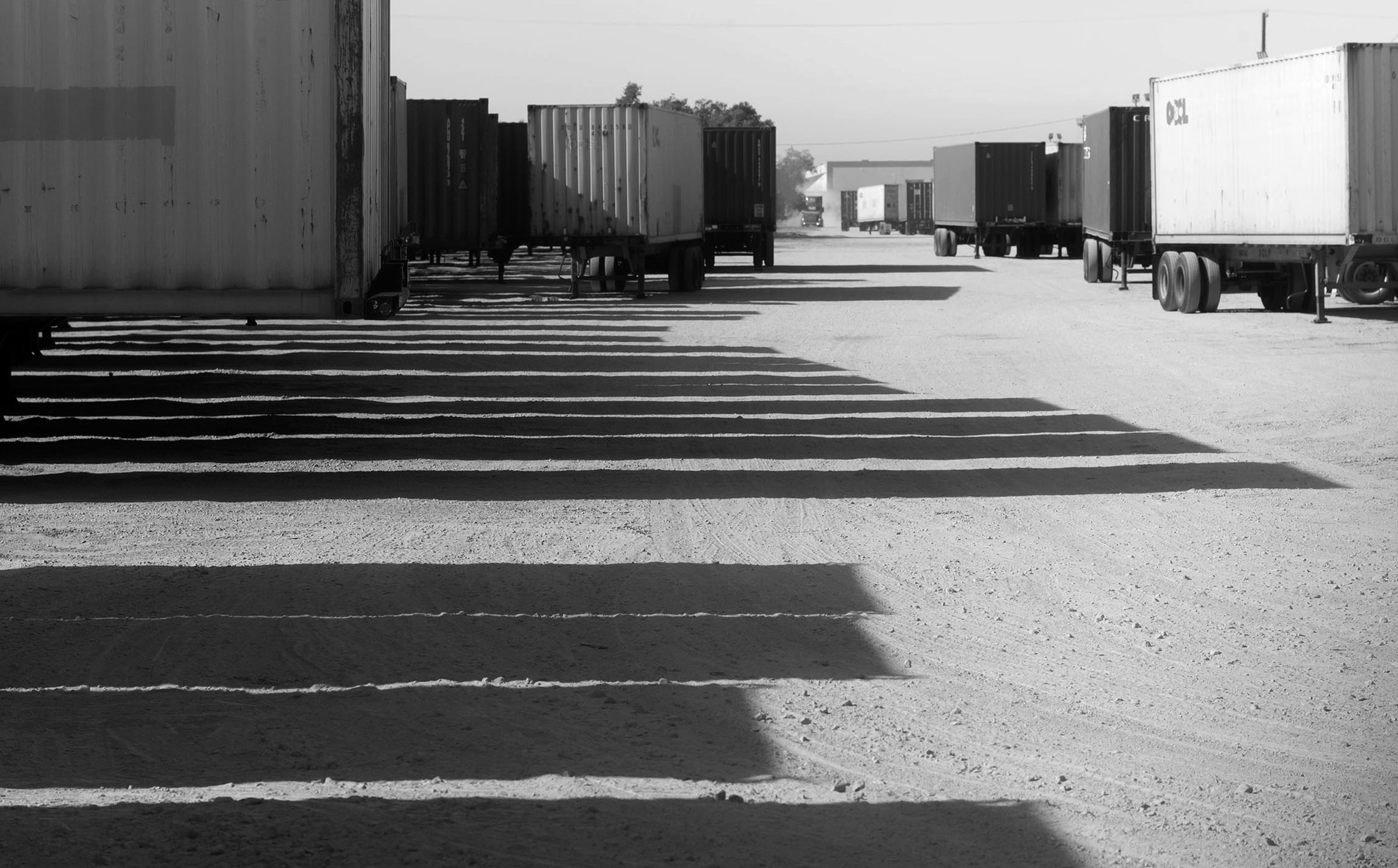
San Bernardino has long been a transportation and distribution hub for the west coast of the U.S. Daniel A. Anderson
In early February, the next showdown between the warehouse industry and the community is scheduled to take place in the U.S. Ninth Circuit Court of Appeals, which will field oral arguments challenging the construction of the Eastgate project. Earthjustice is representing a coalition of community residents, workers, and environmentalists contesting the Federal Aviation Administration’s (FAA) approval of the Eastgate project in late 2019.
In the lawsuit, filed in early 2020, the plaintiffs contend that the FAA greenlit the Eastgate project in violation of federal environmental law after completing a “faulty and incomplete environmental review” and making a determination that the development will not significantly affect the quality of the human environment. In its own environmental assessment, the FAA estimates that the new facility will emit about one ton of pollution daily starting in 2024. “Most fundamentally this case is about the kind of air that we’re going to breathe,” said Agelidis. “And it’s really about the whole premise that we shouldn’t have an online commerce industry that can dump one ton of pollution into people’s backyards every single day without the federal government taking the proper required environmental evaluation of the project like it’s required to do under federal law.”
The San Bernardino International Airport Authority and the developer of the air cargo facility are also named as defendants in the case. Last year, California Attorney General Xavier Becerra sued all three entities for unlawfully approving the controversial airport expansion without adequate environmental analysis, and his agency has intervened in the Ninth Circuit case on behalf of the state. In the lawsuit, the plaintiffs petition the Ninth Circuit Court of Appeals to require the FAA to prepare a more thorough review, known as an environmental impact statement, to provide the community with a better understanding of the impacts of adding around-the-clock flights and truck traffic through the adjacent neighborhoods and the surrounding region.
The plaintiffs are asking the court not only to set aside the FAA’s original findings but also to void the ground lease agreement until the FAA properly complies with requirements set out in the National Environmental Policy Act, or NEPA. That federal law requires that federal agencies assess the environmental consequences (including those that might be cumulative or indirect) of federal infrastructure projects such as pipelines, airports, and highways.
The FAA and the San Bernardino International Airport Authority told Grist that they do not comment on pending litigation, and the developer of the project did not respond to Grist’s request for comment before publication. In court documents filed in response to the lawsuit, attorneys for the FAA and the U.S. Department of Justice asked the court to dismiss the case, arguing that the FAA had fulfilled its NEPA obligations by thoroughly evaluating the potential environmental impacts of the Eastgate project. “Petitioners’ NEPA arguments are meritless, lacking record support and failing to show that FAA’s decision-making was arbitrary or capricious,” the attorneys state in a reply brief filed last fall.
Cesunica Ivey, an assistant professor of chemical and environmental engineering at the University of California, Riverside, told Grist that more research is needed to demonstrate the links between logistics and warehouse activity and the worsening air quality in the Inland Empire. Ivey oversaw a pilot study, published in October in the Journal of Aerosol Sciences, that monitored 18 adults from five different Inland Empire cities over seven days. The study found that San Bernardino residents had higher median exposures to lung-damaging fine particulate matter in their homes than participants from other cities. This particulate matter, called PM 2.5, can lodge in respiratory tract tissues and lead to diseases such as asthma.
“This is just the tip of the iceberg, meant to inspire people to look at these issues in a different way from the research standpoint,” Ivey told Grist. “What we’ve seen is that pollution overall is going down. The disparity gap is not. So how are we going to address the disparity gap?”

A community garden volunteer moves waste in a wheelbarrow in the shadow of a commercial building in San Bernardino, Calif. Daniel A. Anderson
Amazon expanded into the Inland Empire after bix box store competitors like Target, Home Depot, and Walmart were established, but it has expanded at breakneck speed and is now the largest private employer in the Inland Empire region, said Wilson. The company has opened 15 warehouses in the region since establishing its first California fulfillment center in San Bernardino in 2012, according to The Cost of Free Shipping. While big box stores and e-commerce systems are both carbon-intensive enterprises, e-commerce relies far more on air shipping to process frequent and smaller shipments under tight deadlines. University of California, Riverside, Professor Juliann Emmons Alison found that average warehouse size more than doubled between 2007 and 2017, with Amazon’s Southern California fulfillment centers consuming far more space than the typical warehouse — between 600,000 and 1.5 million square feet.
The bottom line is vastly more traffic in surrounding neighborhoods. Wilson has found that the number of daily Amazon deliveries per driver can hit as many as 400 deliveries per shift during peak holiday periods, with profound effects on local air quality, congestion, and noise pollution. “Here you have all of these communities in the Inland Empire region in Southern California who are really absorbing the cost — and it’s the environmental cost, the economic cost for globalization,” said Wilson, who has been studying the logistics and goods movement industry for nearly two decades.
One resident of San Bernardino’s working-class, predominantly Latino West Side community told Grist that the online shopping boom and two-day shipping craze have resulted in “an invasion of warehouses” in the region’s communities of color, which are largely poor and undocumented. “Our land has been taken up because this logistics industry has grown so much,” said Sara, 26, who has lived on the West Side since the age of 5. “And we’re paying the ultimate price here in the Inland Empire with our health, with our land being stolen.” (The resident requested that her real name be withheld because she is undocumented, so Grist is using the pseudonym Sara).
Raised on the West Side near the 215 freeway, Sara said she’s been healthy most of her life, but that began to change in high school, when she started having difficulty breathing. Then, about a year ago, she moved about a block away from the BNSF Railway Company’s rail yard on the West Side, and her breathing became more laborious. She said that residents are bombarded at all hours of the day with noise from trucks and trains that transport imported goods shipped from the ports to the rail hub, which is one of the busiest in the country. Researchers have found that the air around the rail yard is more toxic than other Southern California rail yards and that residents nearby face an elevated cancer risk. One 2005 state assessment of the health risks from pollution surrounding California’s major rail yards found that the yards posed a significant public health risk. Four rail yards presented an excessive cancer risk, with San Bernardino’s posing the most risk of any rail yard in the state.
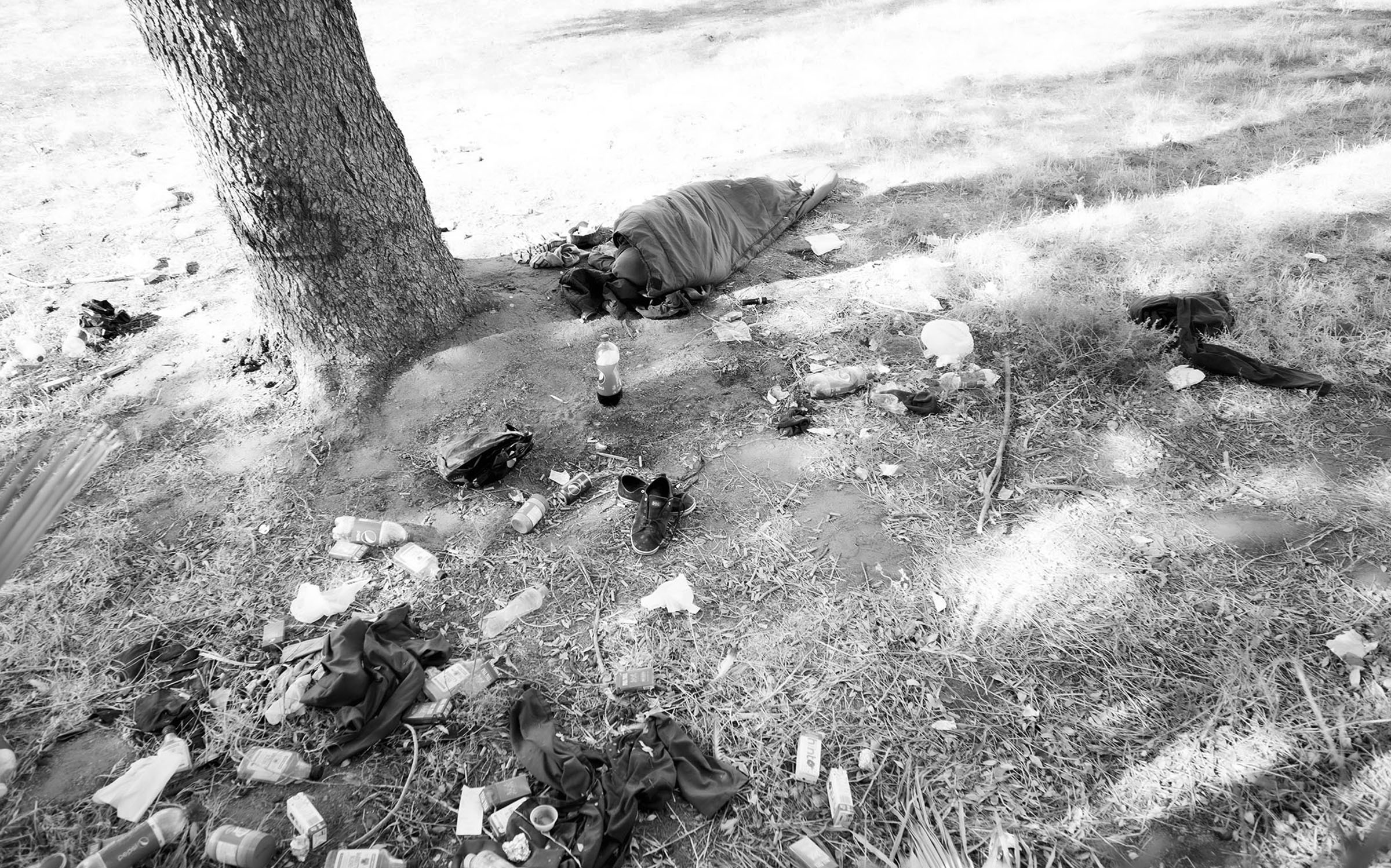
Poverty is evident in this neighborhood near the San Bernardino International Airport. Daniel A. Anderson
While some politicians and community leaders have welcomed the warehouse and logistics industry and touted the development of the new air cargo facility as economic progress, Sara said that narrative doesn’t ring true for residents who live in blighted neighborhoods plagued by violence and crumbling infrastructure. They have seen few resources invested in areas they describe as “diesel death zones” for their proximity to freeways, rail yards, ports, and warehouse clusters. This is why, on last year’s Cyber Monday, Sara spearheaded a banner drop to counter the message promoted by some politicians. With a small group of activists from the newly created People’s Collective for Environmental Justice, Sara constructed banners with messages like “the air is toxic thanks to cyber Monday” and strung them across several 215 freeway overpasses in San Bernardino.
The Inland Empire-based collective launched last summer to eradicate systemic racism, tackle issues such as pollution and police brutality, and establish ways to protect public health and build community self-reliance. The banner drop, while a small action, was nonetheless empowering, said Sara, because it sent a message about a growing resistance to the warehouse industry. “It feels like rebellion a little bit: standing up, and saying ‘no more’… because that’s what we want. We don’t want to be exploited any longer,” said Sara, a nonprofit community organizer.
The grassroots movement that’s been growing around the resistance to the airport expansion is ultimately a fight for a just transition to a clean economy, said Anthony Victoria Midence, a cofounder of the People’s Collective for Environmental Justice. For more than a year, a coalition of residents and labor and environmental advocates have been calling for Amazon to enter into a community benefits agreement that would guarantee jobs with fair wages. Although that agreement never materialized, Victoria Midence said that residents plan to continue to apply pressure and push for the same measures, including worker protections, more training and educational opportunities, as well as a reinvestment in the communities that serve as the workforce for the warehouse and logistics industry.
“Do we want a workforce that will continue to be untrained and provided temporary jobs? Or are we really going to move toward a just transition that is going to center an economic recovery with clean energy jobs and also with better protections,” said Victoria Midence. Residents also want these companies to work more aggressively to mitigate pollution that is generated by the industry, including the adoption of zero-emissions policies such as the electrification of truck fleets.
Last summer, California became the first state in the country to require that automakers sell more electric trucks starting in 2024. By 2045, all trucks sold in the state will be required to be emissions-free. Now, environmental justice advocates in California are working to advance what’s known as a clean fleet rule, which would pressure employers to more rapidly transition to all-electric truck fleets.
While this movement is promising, Victoria Midence’s concern is that local officials have failed to adopt policies to protect vulnerable communities from further pollution exposure. “What’s been missing in this community for decades is community inclusion and community participation,” he said.

A community garden volunteer jumps from a trash bin after making room for more waste as he and others clear the land for plots behind a commercial building. Daniel A. Anderson
Now, advocates are gathering evidence to make their case for a cleaner, greener future. Earlier this year, policy analyst Andrea Vidaurre began collaborating with San Bernardino residents to collect data on truck traffic and air quality before and after the Eastgate Air Cargo Logistics Center begins operating. “Residents know that it’s going to have a huge impact,” said Vidaurre, noting that the FAA’s final environmental assessment projects that Eastgate operations will generate 500 daily truck trips by 2024. “But what does that really mean for somebody who lives and works and walks in that area? We’re hoping to elevate [the issue] even more in the new year,” said Vidaurre, a senior policy analyst for the Warehouse Worker Resource Center, a nonprofit based in nearby Ontario that works to improve working conditions in the warehouse industry in Southern California.
Ivey, the professor who studies particulate matter pollution in the Inland Empire, is advising Vidaurre and described the data collection effort as a way for the community to take matters into their own hands. Another area that requires further study is land-use policy, she said. She recently wrote in the research journal Nature that land-use policy disparities may be an important predictor of COVID-19 disparities. Decades-long practices and policies of placing industrial sources adjacent to vulnerable residential communities inevitably lead to greater exposure to toxic air pollutants in those communities. The question is to what degree. In the case of the Eastgate project, those are questions that should be answered by developers before moving forward, she said.
On San Bernardino’s West Side, Sara told Grist that community awareness around these issues is growing. While she’d prefer not to have to wake up at 4 a.m. to conduct banner drops, Sara said she’s willing to make that investment if that’s what it takes to inform residents. “The movement, I hope, is only going to keep growing. There are a lot of people who have a lot of the same concerns,” said Sara. “And I think we as a people need to rise up.”
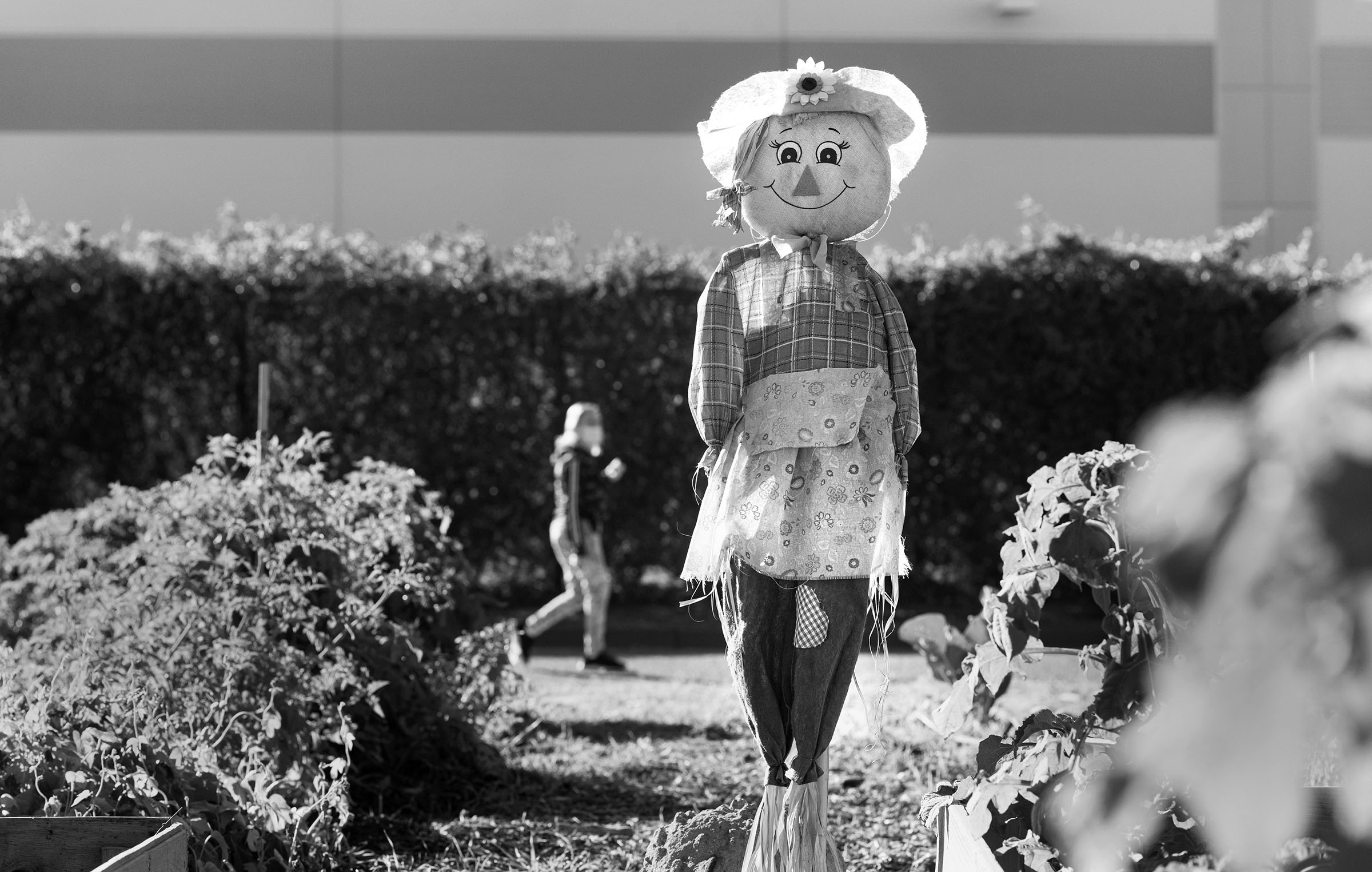
Community garden participants in San Bernardino, Calif., decorated a scarecrow used to keep birds away from their plots. Daniel A. Anderson
Heredia is doing just that. Although Amazon’s Eastgate construction project is nearly complete, for Heredia this doesn’t mean that the battle for a healthier environment is over. On the contrary, in the midst of a neighborhood choked by industry, Heredia is helping to nurture the one asset he believes can still help make a difference in the battle to protect his neighborhood from more pollution: community. Last summer, the academic medical center Loma Linda University Health, in partnership with an Ontario-based urban community farm initiative called Huerta del Valle and local residents like Heredia, helped bring to life an organic community garden in the shadow of one of the warehouses near the airport.
Named the “Garden of Health,” the 1-acre community garden and outdoor activity center offers residents plots of land to grow their own vegetables, with the requirement that they all volunteer several hours a week in the community planting area. Heredia considers the garden the last battleground in the neighborhood’s fight against the warehouse industry in a region considered a food desert due to high poverty levels, food insecurity, and a lack of access to grocery stores. It’s a healthy haven where residents can nurture life with their vegetables and vines, and an oasis of green in a neighborhood where industry is firmly entrenched. “For me being in the garden … it’s like my last hope for what can possibly be here in the community,” said Heredia.

Jorge Osvaldo Heredia, left, and other community garden volunteers clear a field early on a recent Saturday morning in San Bernardino, Calif. Daniel A. Anderson
At a time when many people are working from home — including Heredia, who is the director of a community arts venue in San Bernardino — the garden is also one of the few spaces where residents can safely talk at a distance in an outdoor space. Last summer, they dug trenches to create the garden’s irrigation system, and as they’ve planted their crops residents have shared gardening and composting tips. When they harvest, they exchange the fruits and vegetables they grow: everything from eggplants to tomatoes to peas.
Heredia hopes that this kinship will strengthen the community’s resolve to continue to advocate for their neighbors, and that it will pressure companies like Amazon to be more environmentally responsible by adopting zero-emissions trucks, for example, and supporting more green spaces in the community. It’s a fight that Heredia considers crucial to ensure future developments take the health of the community into consideration. Without these protections in place from the outset, the community will continue to suffer the consequences, he said.
“The community is well aware that it’s impossible really to stop all these warehouse developments,” said Heredia. “It’s really an uphill battle to prevent these warehouses from popping up. What the community is asking for is something to benefit us.”

Community garden volunteer Samuel Armando Castro Marron, 28, of San Bernardino, Calif., helps create a new plot for a future garden. Daniel A. Anderson
One Saturday in early December, Heredia joined a handful of young volunteers clearing a patch of weeds in a space where the group hopes to plant berry bushes and cactus plants. As cumbia songs played in the background, they diligently rolled wheelbarrows full of the weeds to a nearby dumpster. Heredia pushed his rake into the earth and yanked out mound after mound of dry weeds, shook the dirt off, and dumped the tangle of weeds into a growing pile. It was sweaty work in the glaring morning sun, but Heredia carefully separated the valuable earth from the yellowed, dry weeds as a parade of trucks and trailers whizzed by on nearby Tippecanoe Avenue.
Heredia took a break and explained how the work, while tough, has always given him a sense of community. “I feel so let down by elected officials all the time, but then I always get reinvigorated by people in the community who are so willing to help out, lend a hand. Even here within the garden, you have an amazing community of people who are just so open to share — share their knowledge and share their harvest with other gardeners.”
A year after the airport authority commission decided to move forward with the airport expansion, Heredia still feels the sting of a decision that he describes as an outright dismissal of the community. “That moment was really the key moment where I was like: They don’t care. They don’t care what the community has to say whatsoever,” said Heredia. It’s why, week after week, he returns to the garden for that nourishment.
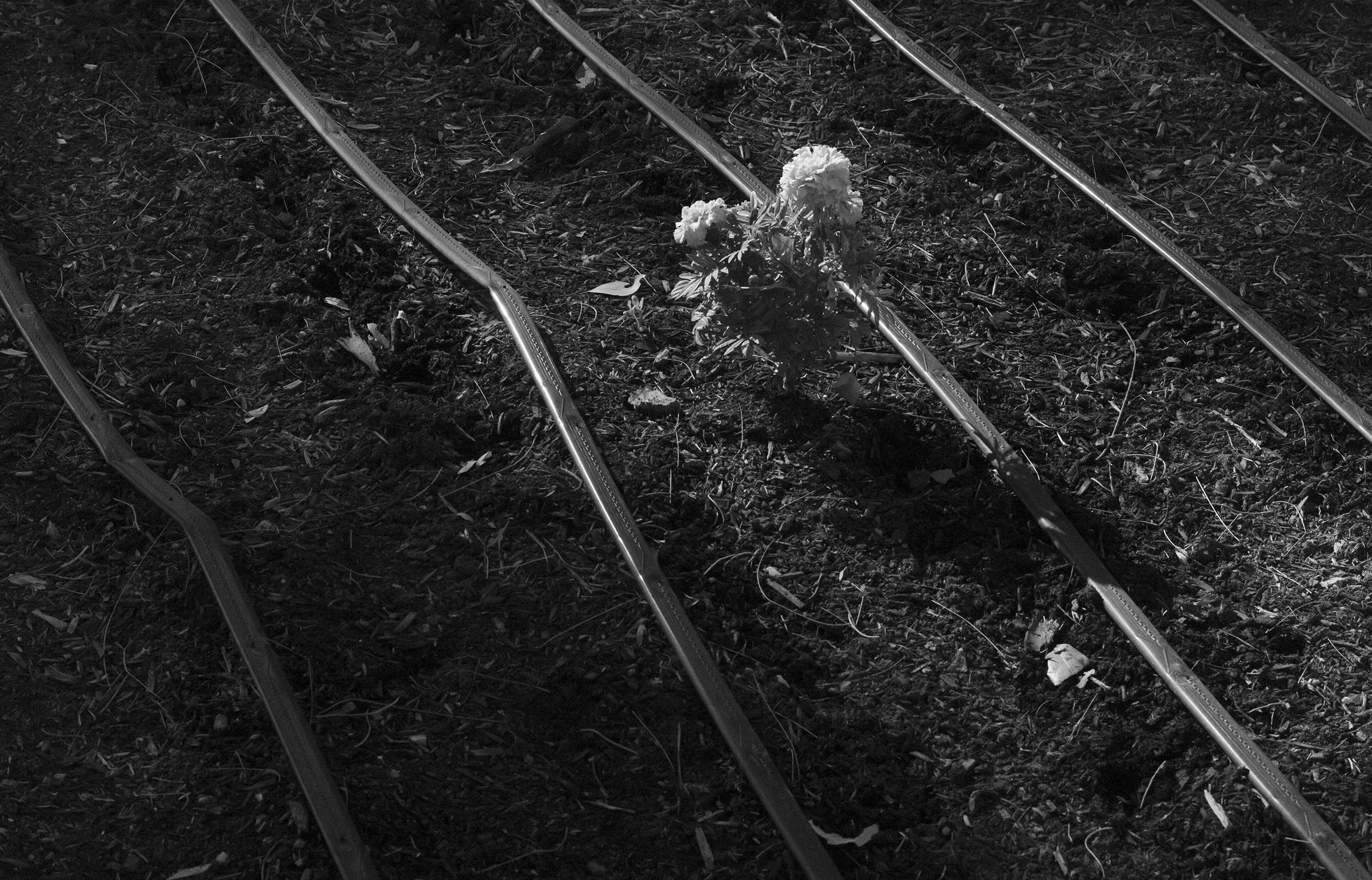
After the fall harvest, a marigold flower remains between drip watering lines. The marigold is a popular flower to decorate Day of the Dead memorials. Daniel A. Anderson
He wants that sense of community for all San Bernardino residents, so Heredia is working across spaces and generations to make that happen. As a member of San Bernardino’s Generation Now, a group of volunteers that promote initiatives like voter registration drives, mural creations, and community festivals, he’s helping others participate in events that can nourish their mental and physical health, while also giving them a voice on community issues. “This area needs to improve on its quality of life,” he said. “For our mental health, for our physical health, definitely this environment is not ideal. That’s why a lot of people leave this area too.”
He points to the motto of California State University, San Bernardino: “Come Here, Go Anywhere.” It’s a message that he interprets as subtly encouraging people to leave the area. “If you escape, it’s like you made it,” said Heredia. He understands why some might leave; there aren’t many job options. His first job at the age of 17 was at a warehouse. He also briefly worked at Amazon about five years ago, pulling warehouse items from the shelves, but the work was isolating and stressful. Ultimately, he left the job to pursue a teaching credential. Heredia plans to stay put in San Bernardino, because he believes it’s important that he do what he can to help his ideas for change take root in the city.
“I guess I’m a fighter in that sense,” said Heredia. “I always have hope that change can happen.”

